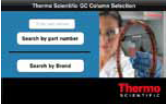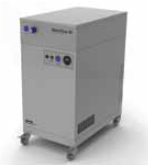The Heart of the Matter
Capillary columns have changed the face of GC since their introduction about 35 years ago. The most obvious change involves resolving power: up to 50,000 theoretical plates on a 30-m capillary versus 1500 on a six-foot packed column.
Capillary columns have changed the face of GC since their introduction about 35 years ago. The most obvious change involves resolving power: up to 50,000 theoretical plates on a 30-m capillary versus 1500 on a six-foot packed column. Capillary columns also permit the rapid heating and cooling that is one hallmark of “fast GC.” Packed columns are still used, however, for high-volume injections and gases in particular or when expert chromatographers wish to experiment with stationary phases.
 Column Selection Tool | GC Column Configurator | Thermo Fisher Scientific | www.thermoscientific.com Major GC system and column manufacturers still emphasize innovation in column technology. “Everyone still pays close attention to the stationary phases, to match column phases to compound classes and reduce bleed,” says Eric Phillips, GC and GC-MS marketing manager at Thermo Fisher Scientific (San Jose, CA). “Column chemistries just keep getting better.”
Column Selection Tool | GC Column Configurator | Thermo Fisher Scientific | www.thermoscientific.com Major GC system and column manufacturers still emphasize innovation in column technology. “Everyone still pays close attention to the stationary phases, to match column phases to compound classes and reduce bleed,” says Eric Phillips, GC and GC-MS marketing manager at Thermo Fisher Scientific (San Jose, CA). “Column chemistries just keep getting better.”
GC column performance depends on the complex interactions among several factors: column length and diameter, chromatographic conditions like mobile phase flow and temperature, and chemical interactions between analytes and stationary phase.
Selecting a GC column begins with the organic chemistry maxim that like dissolves like. “You should target selectivity first,” advises Chris English, who manages Restek’s (Bellefonte, PA) Innovations Laboratory. “If you’re dealing with glycols, select a phase that’s most like a glycol. If you’re analyzing gasoline, select a nonpolar phase like polydimethylsiloxane.” Stationary phases that dissolve analytes provide the optimal retention, assuming optimization of the remaining conditions.
 Gas Generator | NitroFlow 60 Parker Balston | www.parker.com Obtaining acceptable retention is also possible by using a less-than-optimal stationary
Gas Generator | NitroFlow 60 Parker Balston | www.parker.com Obtaining acceptable retention is also possible by using a less-than-optimal stationary
phase in a longer column. Doubling the column length adds approximately 40 percent theoretical improvement in resolution, but the column will cost twice as much and may not last as long as a shorter column.
Similarly, narrower-bore columns resolve analytes more efficiently but require much higher back pressures. Since column capacity is roughly related to the square of column diameter (as with cylinders), loading capacity falls off dramatically from 1 mm to 0.18 or 0.10 mm. This can significantly compress the concentration calibration curve, thus limiting applicable concentration ranges.
Longer columns provide greater efficiency and resolution but at the expense of longer retention times. Thicker stationary phases also improve retention, especially for volatile compounds, but suffer from higher bleed and slightly lower efficiencies.
Delicate Balance
 5 % Phenyl GC Column Range BP5MS | SGE Analytical Science www.sge.com Expert chromatographers achieve the separations they desire by balancing the column’s physical and chemical characteristics. Approximately the same advantage in resolution is gained by switching from a 0.25 mm ID column to 0.18 mm. It is therefore possible to trade off the wider bore for a shorter column and reach approximately the same column efficiency. Similarly one could, at 0.18 mm or even 0.10 mm ID, increase the film thickness to compensate for the lower capacity of narrow-bore capillaries. This will change the number of theoretical plates as well but will maintain to a large degree the required calibration curves.
5 % Phenyl GC Column Range BP5MS | SGE Analytical Science www.sge.com Expert chromatographers achieve the separations they desire by balancing the column’s physical and chemical characteristics. Approximately the same advantage in resolution is gained by switching from a 0.25 mm ID column to 0.18 mm. It is therefore possible to trade off the wider bore for a shorter column and reach approximately the same column efficiency. Similarly one could, at 0.18 mm or even 0.10 mm ID, increase the film thickness to compensate for the lower capacity of narrow-bore capillaries. This will change the number of theoretical plates as well but will maintain to a large degree the required calibration curves.
Phenomenex (Torrance, CA) has an hour-long presentation on its website on selecting a GC column. Kory Kelly, GC product manager offers this tip: “Know your analytes. The most efficient separations depend on differences in their chemical and physical properties.”
GC separates materials based on two properties: boiling point and chemical interactions with the stationary phase. Elution based on boiling point differences is straightforward enough. Those with lower boiling points vaporize and elute first. The wider the boiling point differences, the more complete the separation.
For compounds with very similar boiling points, chromatographers must rely on retention differences based on interactions with the stationary phase. Here the idea of “like dissolves like” comes into play. With a binary mixture of one very polar and one weakly polar compound, a polar column would retain the more polar material more efficiently, while a hydrocarbon-like column would more efficiently retain the less-polar compound.
It’s not quite that simple, however, as the temperature stabilities of the analytes and the column must be considered. This same binary mixture will not separate on highly polar columns with an upper temperature limit of 250º C if one analyte boils at 400º C. “Clearly, maximum column temperature is a fundamental limitation. The strengths and types of interaction between the analytes and stationary phase must be balanced against that number,” Kelly says. Generally speaking, the more strongly a column interacts with analytes (i.e., the more polar the stationary phase), the lower its temperature stability. Highly polar polyethylene glycol stationary phases are stable to about 260º C, whereas the highly nonpolar polydimethylsiloxane is highly temperature-stable.
Analyte stability, while it does not affect the column, may directly or indirectly influence column selection. Highly functionalized molecules of even low molecular weight, for example amino acids, must be derivatized or “capped” to survive GC conditions.
“The goal is to optimize differences in chemical interactions between analytes and the stationary phase,” Kelly notes. This strategy sometimes leads to methods that violate the “like dissolves like” rule. For example 1,2 dimethyl benzene (xylene) easily separates from a nonaromatic hydrocarbon of identical molecular weight. However mixtures of 1,2; 1,3; and 1,4 xylenes have identical molecular weights and aromaticity, have nearly identical boiling points, and will co-elute on a 50 percent phenyl column. However, a very polar cyano or polyethylene glycol stationary phase will induce dipoles in the molecules sufficient to enable clean separation.
Hydrogen or Helium?
The recent helium shortage has created opportunities for cost-effective, alternative carrier gases, but the significance of the switch is by no means settled.
On August 11, 2012, the Wall Street Journal reported, due to a legal quirk, the imminent closure of the Federal Helium Reserve, a profitable heliumproducing
plant initially supported by federal funds. Congress has introduced legislation to keep the plant open, but its future remains in doubt and prices are likely to remain high.
Phil Allison, manager of sales and marketing at Parker Hannifin (Fairfield, NJ) makes a compelling argument for hydrogen generators replacing helium tanks, based on the newer technology’s cost-effectiveness and convenience.
“The helium shortage became a buzz a few years ago; then died out, then returned,” Allison says. “Over the past six months we’ve seen a definite uptick in chromatographers seeking alternatives to helium cylinders.”
Cost and convenience are major drivers. Allison reports that one of his customers used to go through six helium cylinders per week, at a cost of $345 each. “That puts the economic advantages of on-site hydrogen generation into perspective.” The shortage is so dire, Allison says, that consumer markets (e.g., party stores) are feeling the pinch. “Clearly the tight market is causing rationing or at best is forcing users to settle for lower-grade gas.”
Price is just one component of the cost of tanked gases, Allison says. Indirect costs like cylinder rental, delivery fees, administrative costs, tank management, wastage (only 90 to 95 percent of tanked gas is accessible), inventorying, and complying with codes and standards add approximately $100 to the cost per cylinder.
That is why Parker Hannifin views replacing helium tanks with hydrogen cylinders as a halfway solution. Tanks are cumbersome, costly to transport and rent, and dangerous due to their sheer weight.
Parker Hannifin specializes in on-site generators that use a palladium membrane to produce high-quality hydrogen through water electrolysis. According to Allison, generators can pay for themselves in about one year, but ROI varies depending on volumes.
At just one-fourth the density of helium and one-twenty-eighth that of nitrogen, hydrogen travels much faster through capillary columns and spares the column by permitting lower-temperature elution. Allison claims hydrogen also provides greater sensitivity at the detector end and requires no retrofitting or modification to recent vintage instruments. “Almost every GC manufactured today has the capacity to use hydrogen carrier gas.”
Hydrogen has suffered a bad reputation since the Hindenburg disaster in 1937. The tiniest spark causes hydrogen to combine explosively with atmospheric oxygen. Yet generators create hydrogen on demand, so the buildup of dangerously large volumes is impossible. The plumbing between generator and instrument is protected against potential sources of sparks, and built-in electronic pressure control shuts generators down if the gas line is compromised.
“Hydrogen has the benefit of providing better resolution than helium, which creates the opportunity to speed up GC analysis,” says Cynthia Cai, Agilent gas phase solutions and commercialization manager. It also frees chromatographers from the vagaries of the specialty gas marketplace, especially when a hydrogen generator replaces hydrogen cylinders. But Cai notes that “using hydrogen as a carrier gas requires additional safety precautions,” and the switch from more common carrier gases will likely affect methods.
Not everyone agrees that hydrogen is a panacea. An August 27 article in Forbes online indicated that shortages are due to temporary events like pipelines and production facilities closing for routine maintenance. According to the U.S. Geological Survey, the world’s helium consumption is 180 million cubic meters but reserves are estimated at 50 billion cubic meters—a 300-year supply. Moreover new sources
are coming online as a side-product of shale gas extraction (fracking).
Fran Kandl, product manager for specialty gas equipment at Airgas (Allentown, PA), is among the helium shortage skeptics. While acknowledging that prices have risen and that hydrogen as a carrier gas can be beneficial in some circumstances, he cites overusage and waste as factors that cloud the actual cost of carrier gas helium. “In most cases, the helium consumed for [non-GC] lab applications is much higher than what the GCs actually use. A GC running continuously consumes between 20 and 40 cubic feet per month, so one 300-cubic-foot cylinder can run five to six instruments for a month.”
Waste includes overuse of carrier gas, fuel gas, gas vented off the split-purge, and makeup gases, plus leaks. Because of hydrogen’s lower density and molecular weight, the cumulative effects of leaks are magnified relative to helium. Airgas provides customers with a gas flow calculator that quantifies potential sources of waste and a program that teaches customers how to conserve gas by making modest modifications to the gas delivery system and usage practices.
Perhaps the best argument against switching to hydrogen involves validated methods. Many labs, particularly in pharmaceutical, environmental, and forensics, employ methods from FDA, EPA, ISO, etc., that may require validation of every peak. The helium-tohydrogen switch would entail rewriting and revalidating methods—a costly, time-consuming exercise.
“The helium shortage provides the incentive for us to work with our customers to dramatically reduce their usage of carrier gases,” Kandl says. “Even with the shortage, it’s possible to save 30 percent without even trying very hard.”
